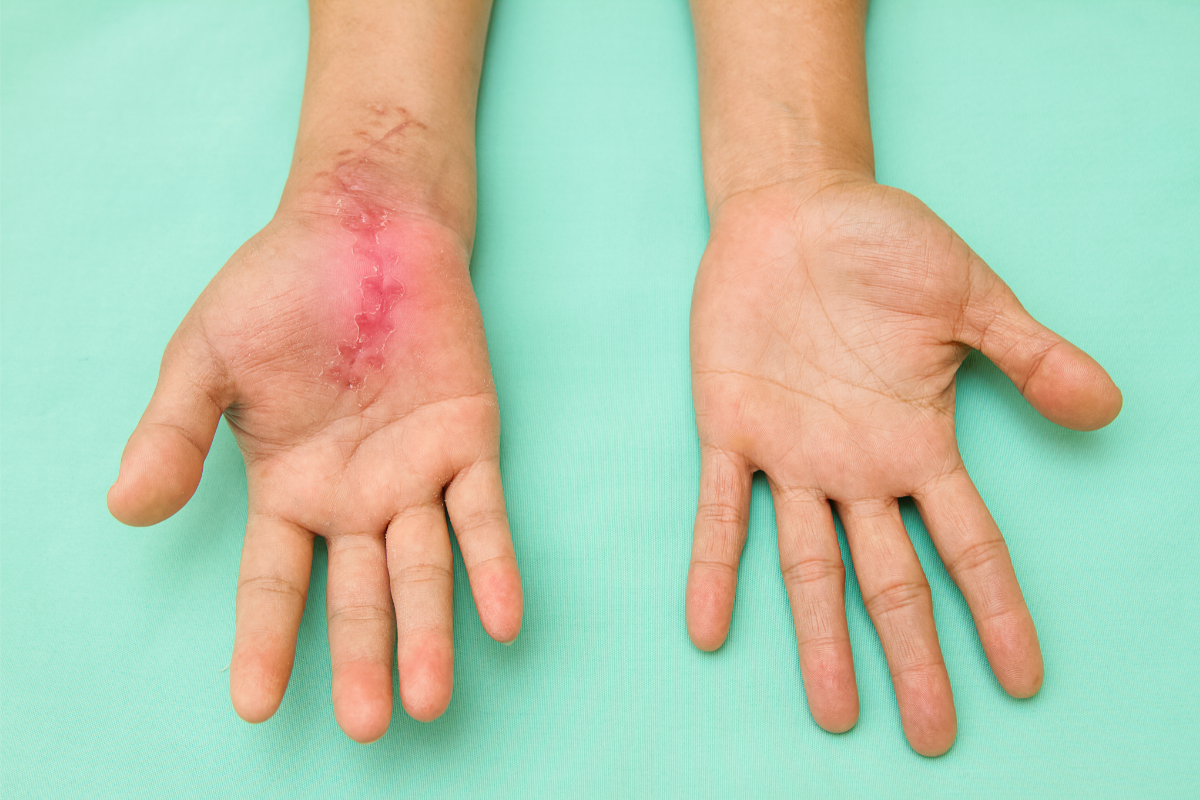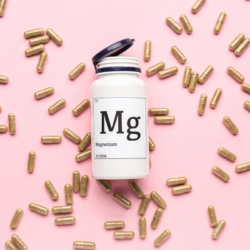Hypertrophic scars and keloids can be a source of pain, discomfort and worry for many people. Whether caused by surgery, burns, injury or infection, their appearance can have a significant impact on quality of life. Fortunately, there are a number of treatments available to improve the appearance of scars and reduce their symptoms. In this article, we’ll look at the differences between hypertrophic and keloid scars. We will also look at the different treatment options available to help reduce symptoms and improve the appearance of scars.
The keloid scar is a complicated hypertrophic scar
A keloid scar is a form of hypertrophic scarring. In other words, it develops excessively in relation to the initial injury. However, unlike a classic hypertrophic scar, the keloid scar spreads beyond this area and can continue to grow over time.
Keloid scarring occurs when the skin’s healing process is disrupted, leading to excessive production of collagen and other scar tissue. It can develop following a variety of injuries, such as cuts, burns, piercings or tattoos. The areas of the body most commonly affected are the shoulders, chest, back and ear.
As well as looking unsightly, keloid scars can also cause itching, pain or increased sensitivity. Treatments available for keloid scars include creams, corticosteroid injections, cryotherapy, laser therapy, surgery or a combination of these options. However, no treatment is guaranteed to completely eliminate a keloid scar.
What is the difference between a hypertrophic scar and a keloid scar?
A hypertrophic scar forms about a month after surgery and remains limited to the area of the initial injury. It tends to regress spontaneously within one to two years.
Keloid scars, on the other hand, form about three to six months after surgery and may extend beyond the area of the initial injury. Although some keloid scars may regress naturally within seven years, they tend to persist indefinitely and may continue to grow over time.
Thus, the main difference between the two types of scars is that hypertrophic scars remain limited to the area of the initial injury and regress spontaneously in one to two years, whereas keloid scars may extend beyond the area of the initial injury and do not always regress spontaneously.
How can hypertrophic or keloid scars be prevented and treated?
There are several ways of preventing and treating hypertrophic scars or keloids. Preventing hypertrophic scars and keloids, particularly in people with a predisposition to them, is a crucial step in maintaining the integrity of skin tissue and promoting normal scarring. Here are some effective prevention strategies:
- Silicone gels can be applied to the closed scar for 3 to 6 months. They work by reducing the evaporation of water from the stratum corneum, thereby reducing the size and appearance of the scar.
- Strong compression can also be used as a preventive measure, particularly on burns, or on closed scars. Compression garments or silicone masks are often used for this purpose.
- Intra-lesional injections are another treatment option, and include corticosteroids, 5 FU (antimetabolite), bleomycin (antineoplastic) and interferon (cytokine). The aim of these injections is to inhibit fibroblast proliferation and inflammation, while reducing the synthesis of collagen I and III.
- Surgery is also a treatment option, although it is often combined with other means. However, the recurrence rate can be high, up to 100%.
- Laser treatment, including CO2, YAG, pulsed light and phototherapy, can also be used, although results are variable.
- Cryotherapy (cold) can also be used, with intra-cicatricial liquid nitrogen.
- Avoiding non-essential procedures: People with a history of abnormal scarring, particularly those with skin types prone to scarring, such as black skin, are advised to limit surgical procedures and piercings. Each new incision or injury can potentially trigger the appearance of a hypertrophic or keloid scar.
- Controlling inflammatory scarring: Early control of inflammation in scar tissue can prevent the development of hypertrophic scarring or keloids. The use of anti-inflammatory drugs, under medical advice, can be beneficial in the early stages of the scarring process.
- Education and awareness: Informing patients about the types of scars, risk factors and prevention methods is essential. This includes advice on scar treatment, products to use and warning signs of abnormal scarring.
- Early monitoring and intervention: Regular monitoring of recent scars is crucial, particularly for people at risk. Early intervention at the first sign of an abnormal scar may include treatments such as corticosteroid injections to remove or reduce excessive scar tissue.
Pigmented scars
Pigmented scarring is a form of scarring characterised by dyschromia, circulatory disorders and hyper- or hypopigmentation. This can occur following a variety of injuries, such as burns, cuts, insect bites or surgery.
As the skin heals, it can disrupt the pigmentation process, resulting in pigmented patches that are lighter or darker than the surrounding skin. Hypo-pigmented scars, i.e. scars that are lighter than the surrounding skin, are often found after burns. Pigmented scars may also show redness, dilated veins or blood circulation problems.
The impact of pigmented scars is mainly aesthetic. However, it can also affect the patient’s quality of life. For example, scars on the face or hands can have a negative impact on self-confidence and self-esteem.
Fortunately, there are several treatments for pigmented scars. These options may include the use of depigmenting creams, lasers, light therapies or injections. However, the choice of treatment will depend on the cause, severity and location. It is therefore important to consult a dermatologist or cosmetic surgeon for professional advice.
Scarring experience
Scar assessment scales increasingly take into account the scar experience. This is known as the patient and observer scar assessment scale (EECPO). Psychological feelings may vary depending on the relationship with the patient’s family and medical environment. It may also depend on the location of the scar, the patient’s profession or the functional and aesthetic impact.
Scars can have pathological characteristics such as hypertrophy, retraction or dyschromia. Keloids, which are often genetic in origin, are painful, progressive and difficult to treat. Retractile scars can compromise functional prognosis. Hyper- or hypopigmentation can affect the aesthetic appearance of the scar.
The first experiments on scarring took place at the beginning of the 20th century with the Lumière brothers. In particular, Auguste Lumière created the famous “Tulle gras®“, a dressing that promotes healing by maintaining a moist environment. In 1962, Georges Winter conducted experiments on animal models to study the results of wound healing in a moist environment versus in the open air or with a warm draught. The results confirmed the importance of maintaining a moist environment to promote healing. This also gave rise to the principle of moist wound healing.
What are the main principles of wound healing?
The main principles of wound healing include several important elements. Firstly, wound healing occurs more rapidly in a moist environment. Secondly, all wounds go through three main phases of healing: detersion, budding and epidermisation.
Another important principle is to abandon the systematic use of antiseptics and most local antibiotics and dyes. These products often have potential side-effects. For example, allergies, systemic toxicity or selection of germs. In most cases, a simple wash with saline solution, shower or soap is sufficient.
It should be noted that bacterial flora naturally colonise all wounds and that, except in excess, they are not harmful and can even contribute to detersion.
Finally, it is important to remember that treating a wound does not only involve treating the wound itself, but also taking into account the patient’s general condition. No dressing can work miracles, and it is important to treat the underlying cause of the wound. For example, using a compression bandage for a venous ulcer or relieving the affected area for a patient suffering from a pressure sore.
The management of a wound is multifactorial, which makes it complex
Managing a wound is a complex and multifactorial task. Some wound care tasks can be carried out in an autonomous role within the nurse’s scope of practice. Others require a medical prescription. The skin is a vital organ with multiple roles, including protecting the body against infection and trauma. When a wound occurs, the healing process can be divided into three stages. These stages are detersion, budding and epidermisation, followed by a long remodelling phase.
However, there are many factors that can delay wound healing. These include smoking, diabetes, obesity and nutritional deficiencies, among others. It is therefore important to take these factors into account to optimise the healing process. Controlled healing techniques can be used for wounds that cannot be sutured. These techniques encourage the formation of granulation tissue. In addition, healthcare professionals can use different types of suture depending on the size, location and severity of the wound.
The main principle of wound healing is to maintain an optimal moist environment to promote healing. You therefore need to choose the right care products to maintain a moist environment while preventing infection.
In summary, preventing hypertrophic and keloid scars involves a proactive approach, avoiding known risk factors and applying effective wound care strategies. These measures can significantly reduce the risk of recurrence and help maintain normal, healthy skin healing. However, it is important to note that each hypertrophic scar or keloid situation is unique, and healthcare professionals must tailor treatment accordingly. We therefore recommend consulting a dermatologist or cosmetic surgeon to determine the best treatment for your case.
FAQ : Treatment and prevention of hypertrophic and keloid scars
- What is the difference between a hypertrophic scar and a keloid?
- Hypertrophic scars are thick, raised, but limited to the area of the original injury. Keloids, on the other hand, are also raised but extend beyond the boundaries of the original wound, and are often more difficult to treat.
- How can hypertrophic scars or keloids be prevented?
- Prevention includes avoiding unnecessary surgery and piercings, good wound management, the use of silicone gel dressings, and early control of inflammation. People at risk should be particularly vigilant in following these recommendations.
- Are healing creams effective against these types of scars?
- Scar creams can help maintain skin hydration and reduce inflammation, which can be beneficial in the healing process. However, their effectiveness varies according to the type of scar and the individual.
- Are corticosteroid injections a safe treatment for keloids?
- Corticosteroid injections are commonly used to treat keloids, as they can reduce inflammation and flatten the scar. However, this treatment must be carried out by a qualified healthcare professional.
- Is it possible to completely remove a keloid?
- It is difficult to completely remove a keloid. Current treatments aim to reduce the size, thickness and discomfort associated with the scar. In some cases, a combination of treatments may be necessary to obtain the best results.
- Is surgery an option for removing a keloid?
- Surgery can be considered to remove a keloid, but the risk of recurrence is high. Surgery is often combined with other treatments, such as corticosteroid injections or radiotherapy, to reduce this risk.







